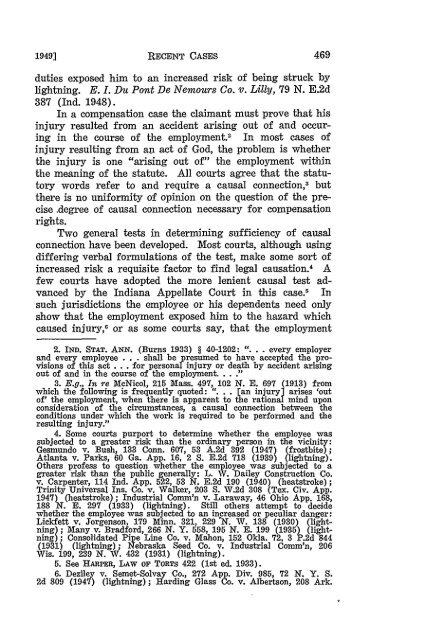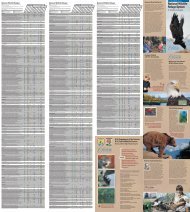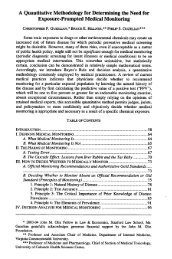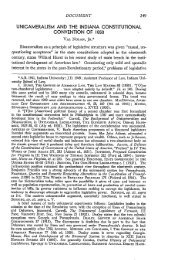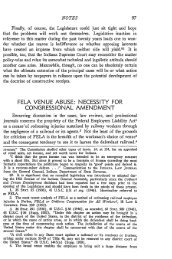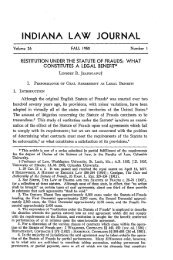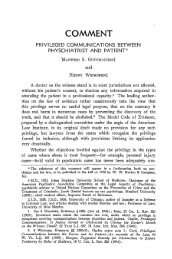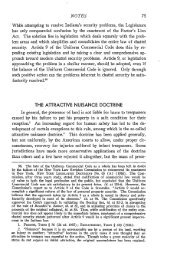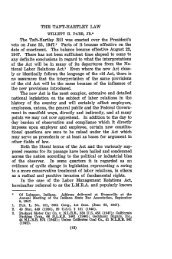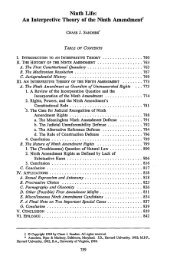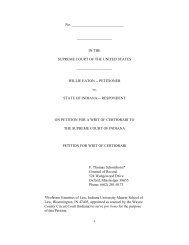Test of Causation Between Employment and Injury - Indiana Law ...
Test of Causation Between Employment and Injury - Indiana Law ...
Test of Causation Between Employment and Injury - Indiana Law ...
Create successful ePaper yourself
Turn your PDF publications into a flip-book with our unique Google optimized e-Paper software.
19491<br />
RECENT CASES<br />
duties exposed him to an increased risk <strong>of</strong> being struck by<br />
lightning. E. I. Du Pont De Nemours Co. v. Lilly, 79 N. E.2d<br />
387 (Ind. 1948).<br />
In a compensation case the claimant must prove that his<br />
injury resulted from an accident arising out <strong>of</strong> <strong>and</strong> occuring<br />
in the course <strong>of</strong> the employment. 2 In most cases <strong>of</strong><br />
injury resulting from an act <strong>of</strong> God, the problem is whether<br />
the injury is one "arising out <strong>of</strong>" the employment within<br />
the meaning <strong>of</strong> the statute. All courts agree that the statutory<br />
words refer to <strong>and</strong> require a causal connection, 3 but<br />
there is no uniformity <strong>of</strong> opinion on the question <strong>of</strong> the precise<br />
.degree <strong>of</strong> causal connection necessary for compensation<br />
rights.<br />
Two general tests in determining sufficiency <strong>of</strong> causal<br />
connection have been developed. Most courts, although using<br />
differing verbal formulations <strong>of</strong> the test, make some sort <strong>of</strong><br />
increased risk a requisite factor to find legal causation. 4 A<br />
few courts have adopted the more lenient causal test advanced<br />
by the <strong>Indiana</strong> Appellate Court in this case. 5 In<br />
such jurisdictions the employee or his dependents need only<br />
show that the employment exposed him to the hazard which<br />
caused injury," or as some courts say, that the employment<br />
2. IND. STAT. ANN. (Burns 1933) § 40-1202: ". . . every employer<br />
<strong>and</strong> every employee . . . shall be presumed to have accepted the provisions<br />
<strong>of</strong> this act .. . for personal injury or death by accident arising<br />
out <strong>of</strong> <strong>and</strong> in the course <strong>of</strong> the employment ...<br />
3. E.g., In re McNicol, 215 Mass. 497, 102 N. E. 697 (1913) from<br />
which the following is frequently quoted: ". . . [an injury] arises 'out<br />
<strong>of</strong>' the employment, when there is apparent to the rational mind upon<br />
consideration <strong>of</strong> the circumstances, a causal connection between the<br />
conditions under which the work is required to be performed <strong>and</strong> the<br />
resulting injury."<br />
4. Some courts purport to determine whether the employee was<br />
subjected to a greater risk than the ordinary person in the vicinity:<br />
Gesmundo v. Bush, 133 Conn. 607, 53 A.2d 392 (1947) (frostbite);<br />
Atlanta v. Parks, 60 Ga. App. 16, 2 S. E.2d 718 (1939) (lightning).<br />
Others pr<strong>of</strong>ess to question whether the employee was subjected to a<br />
greater risk than the public generally: L. W. Dailey Construction Co.<br />
v. Carpenter, 114 Ind. App. 522, 53 N. E.2d 190 (1940) (heatstroke);<br />
Trinity Universal Ins. Co. v. Walker, 203 S. W.2d 308 (Tex. Civ. App.<br />
1947) (heatstroke); Industrial Comm'n v. Laraway, 46 Ohio App. 168,<br />
188 N. E. 297 (1933) (lightning). Still others attempt to decide<br />
whether the employee was subjected to an increased or peculiar danger:<br />
Lickfett v. Jorgenson, 179 Minn. 321, 229 *N. W. 138 (1930) (lightning)<br />
; Many v. Bradford, 266 N. Y. 558, 195 N. E. 199 (1935) (lightning);<br />
Consolidated Pipe Line Co. v. Mahon, 152 Okla. 72, 3 P.2d 844<br />
(1931) (lightning); Nebraska Seed Co. v. Industrial Comm'n, 206<br />
Wis. 199, 239 N. W. 432 (1931) (lightning).<br />
5. See HARPER, LAW OF TORTs 422 (1st ed. 1933).<br />
6. Deziley v. Semet-Solvay Co., 272 App. Div. 985, 72 N. Y. S.<br />
2d 809 (1947) (lightning); Harding Glass Co. v. Albertson, 208 Ark.


